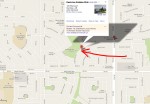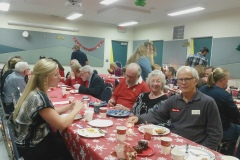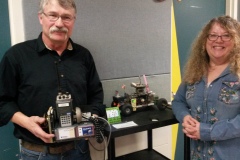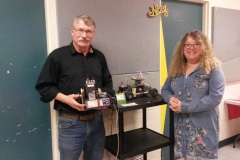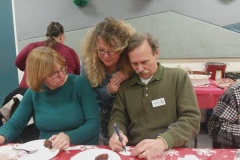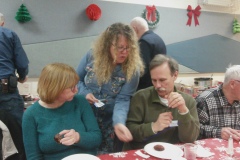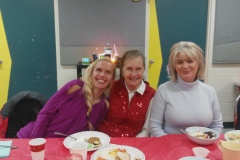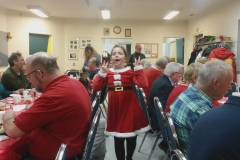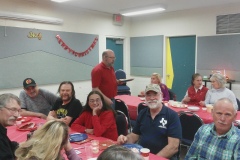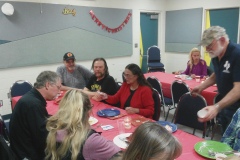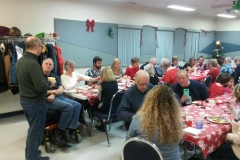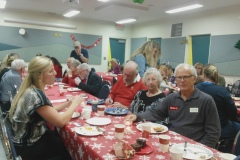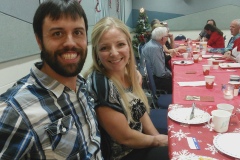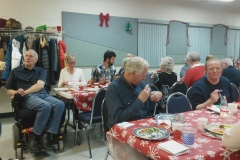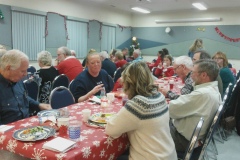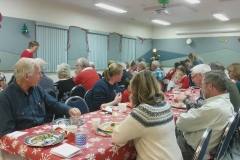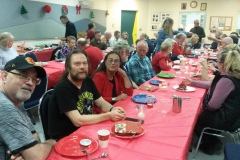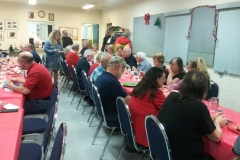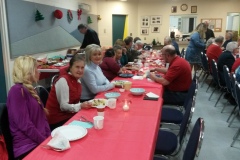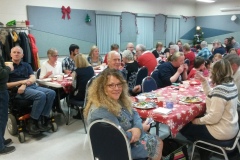- Home
- Registration
- Site Tools
- Articles
- Swap n Shop
- Contesting
- Grounding information for everyone
- History of the Central Alberta Amateur Radio Club
- CAARC owned Repeaters
- Club Repeater Info
- GMT Time Conversion Table
- VE/VA6 Incoming QSL Bureau
- Pine Lake Tornado Friday July 14, 2000.
- Amateur Radio to the Rescue
- CANWARN
- HAM Nation with Bob Heil K9EID
- Net info
- Events.
- ARES
- Links and On line study course.
- Field Day 2019
- Members D/L
- Forum/Swap and Shop
Cochrane Winter Rally 2020
Feb 1st
There is an opportunities for public service at the upcoming Cochrane Winter Rally. This event is sponsored by the Calgary Sports Car Club and is one of the best radio service events of the winter season. Some of you have already helped us to advertise this event, so please accept my thanks for the efforts that you have made to date.
I am helping to organize the rally and one of my responsibilities is to recruit radio operators for the event. The rallies are some of the best field radio operations opportunities available to the Amateur Radio community in our region. They are challenging, fun, and a great way to test your equipment and skills in “real world” conditions. I hope that members of your club will consider joining us.
This year’s event takes place on Sunday 08 March in the Waiparous region northwest of Cochrane. Radio operators are needed to provide communication services and safety observation at various locations throughout the course. Training is provided, so no prior experience is required.
Additional information is available at the URLs noted below. Please consider circulating this invitation among your club’s members.
General event information is posted on the Rallywest website, at:
https://www.rallywest.com/events
Information that is specific to radio operators is posted in the following forum:
Registration instructions have been posted in this forum. Anyone interested in helping at the rally should check this forum regularly for updates.
Thank you for your assistance and please contact me with any questions you may have.
73,
Garry, VE6GDS
VE6GDS@gmail.com
‘I thought it was a dying art’: Why this Hamilton veteran wants to revive ham radio
Dec 31st
‘I thought it was a dying art’: Why this Hamilton veteran wants to revive ham radio
Click this link for the whole story
The Annual CAARC Christmas Pot Luck Supper
Dec 4th
The Annual CAARC Christmas Pot Luck Supper
was held on Sunday December 1st in east Red Deer at the
Eastview Estates Community Association Center.
About 43 people enjoyed a tremendous pot luck supper with ham turkey and tons of other dishes. Marvin VE6CJY was the lucky winner of the new and old GIZMO.
New CAARC Executive 2019 – 2020
Nov 27th
New web site encryption coming soon.
Oct 31st
Within the next week or so dreamhost will be adding secure hosting (https) to all customer subdomains hosted on either dreamhosters.com or dream.press, Traffic to and from this site will soon be encrypted by default, ensuring that its contents can’t be intercepted en route by any unauthorized third parties on the web.
That’s right – visitors to this site will start to see the little green lock icon next to your web address in their browser.
You will see no downtime as a result of this change. You’ll simply start receiving the benefit of encrypted transmissions within the next few weeks.
Thankyou
VE6BLD
Web Site Administrator
VE6XY silent key
Sep 19th
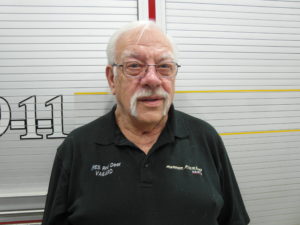
A funeral service for VE6XY Rod Lins President of CAARC was held on Friday the 27th of Sept. 2019 at Wilson’s Funeral Home Lacombe, AB.
CAARC Field Day 2019 has Come and Gone
Sep 12th
By John VA6SJA CAARC Field Day Chairman 2019
We had a field day! It happened because of the participation of interested people. Good job everyone! There are many stories, and I don’t have space to tell them all and there are some that I probably don’t know. Feel free to post your story.
CAARC had sponsored a Class 1F Field Day held at the Red Deer County Emergency Communications Centre in June of 2018.
BOB VE6BLD advocated for a fun Field Day with generators at the October 2018 CAARC general meeting. I had hoped there could be a repeat of last year’s County Class F Field Day as well as to hold this Class A Field Day. But this first independent CAARC Class 3A Field Day took a lot of organizing, and Ryan VA6DSJ, who could allow us access to the County’s Emergency Communications Centre was on emergency assignment dealing with an Alberta wildfire. So, this year’s Class F Field Day was cancelled and this Class 3A Field Day had to do for this year.
I had made a participant and visitor log book allowing for 35 entries and there weren’t enough lines! Hams and former hams came from as far away as Canmore and Edmonton. More hams and family members came for the roast pork supper. At least one couple came because they saw the Field Day signs on the road,
And we got photos that help tell our story! View them on this site.
All the participants worked together to make this event happen. A good example is the set up and troubleshooting needed to get everything working, including improvising on the spot. For one instance, on Friday afternoon Bob VE6BLD and Darcy VE6DDD looked around to find a way to replace the missing centre insulator for the driven element on the Mosley TA-33 Jr. beam that Garry VE6CIA had lent us. They found a discarded snow shovel with a fiberglass handle. Darcy spliced it into place with the help of cable ties and electrical tape and the crew put it in place on top of one of Bob’s masts that could be assembled from the bottom.
Field Day 2019– 99 pictures.
Jun 28th
I finally found a new Gallery widget to add multiple pictures at a time!! Check out the field day pictures by clicking the Field Day 2019 TAB right of the Swap and Shop. Thanks to Bob VE6BLD, John VA6SJA and Ray VA6RSO for the pictures.
Click any picture or click View Slideshow below the pictures.
Bob VE6BLD
HAM RADIO 2019 in Friedrichshafen Reports 14,300 Attended from 50 Countries
Jun 28th
06/27/2019
While thousands were enjoying ARRL Field Day over the June 21 – 23 weekend, some 14,300 visitors from more than 50 countries arrived on the shores of Lake Constance in Friedrichshafen, Germany, for HAM RADIO 2019. Show officials said this 44th event attracted about 400 more visitors this year. The previously reported 2018 attendance of 15,460 included radio amateurs, invited Scouts, and attendees at the concurrent and co-located Maker Faire, which did not take place at this year’s show. This year’s show boasted 184 exhibitors and associations from 32 countries.
ARRL fielded a contingent of representatives to HAM RADIO 2019, headed by President Rick Roderick, K5UR.
“The ARRL booth was busy,†reported ARRL Product Development Manager Bob Inderbitzen, NQ1R. “Many international attendees joined ARRL or renewed their memberships. It was nice to meet so many radio amateurs from around the globe.â€
Inderbitzen said a substantial line formed on Friday and Saturday morning as applicants for DXCC and other popular ARRL Award programs queued up to have their QSL cards verified by volunteer ARRL Card Checkers. Some 40 candidates sat for their US license examinations on Saturday, organized by ARRL Volunteer Examiner team leader Manfred Lauterborn, DK2PZ/K2PZ.
Inderbitzen added that many international attendees joined ARRL or renewed their memberships. “QST is enjoyed the world over,†he said. ARRL has nearly 9,000 international members.
Inderbitzen also said he was struck by the large number of younger attendees. “Many of these young radio amateurs and prospective hams attended Ham Camp,†Inderbitzen said. “A large contingent representing Youngsters on the Air (YOTA), an initiative of IARU Region 1, helped promote the 2019 YOTA summer camp, August 11 – 17 in Bulgaria. During HAM RADIO, young hams carried the YOTA flag to each of the stands organized by International Amateur Radio Union (IARU) member-societies, gathering crowds to cheer on the young hams.â€
ARRL representatives attending the convention in Germany also included International Affairs Vice President Jay Bellows, K0QB; CEO Howard Michel, WB2ITX, and Regulatory Information Manager Dan Henderson, N1ND.
HAM RADIO 2020 will take place June 26 – 28.

